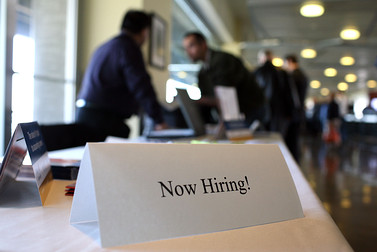
US jobless claims decline weekly; GDP growth is revised upward for the third quarter
Last week, Americans’ new jobless benefit applications dropped more than anticipated, erasing the previous week’s spike and indicating that a downturn in the labor market was still ongoing.
Additional data released on Thursday revealed that strong consumer spending drove the economy’s third-quarter growth, which was faster than anticipated. The positive study, which was released the day after the Fed cut interest rates for the third time in a row, only forecasted two rate cuts in 2025, pointing to the economy’s ongoing resiliency and still high inflation.
The “downside risks of the labor market do appear to have diminished,” Fed Chair Jerome Powell told reporters Wednesday, adding that “the U.S. economy has just been remarkable, I feel very good about where the economy is.”
According to Oren Klachkin, financial markets economist at Nationwide, “the economy is set to end 2024 on a solid note, which is fortunate because we’ll have to contend with heightened policy uncertainty and possibly greater challenges in 2025.”
The Labor Department reported that initial state unemployment benefits claims fell 22,000 to a seasonally adjusted 220,000 for the week ending December 14. Reuters polled economists, who predicted 230,000 claims for the most recent week. Last week, they had surged 17,000 points. The claims industry has entered a volatile phase when the statistics may fluctuate significantly.
Large declines in New York, California, Georgia, Illinois, Michigan, Minnesota, Texas, Washington state, Wisconsin, New Jersey, and Ohio caused unadjusted claims to plummet from 57,932 to 251,527 last week.
Although the labor market is slowing down in a controlled manner, a number of indications, such as job postings, indicate that conditions are far more relaxed than they were prior to the COVID-19 epidemic.
Following a spike in the unemployment rate from 3.7% at the beginning of the year to 4.3% in July, the U.S. central bank began its policy easing cycle in September with an exceptionally big half-percentage-point interest rate drop. In the range of 4.25% to 4.50%, the Fed lowered its benchmark overnight interest rate by 25 basis points on Wednesday.
The Fed had projected four quarter-point rate decreases in 2025 in September. The most recent projections for next year’s rate cut path also reflected uncertainty surrounding the policies of President-elect Donald Trump’s incoming administration, which economists have warned would be inflationary and include mass deportations of undocumented immigrants, tax cuts, and tariffs on imported goods.
To control inflation, the Fed raised its policy rate by 5.25 percentage points between March 2022 and July 2023.
In comparison to a basket of currencies, the dollar remained stable. Treasury yields in the US increased.
“US unemployment claims” is a column chart that shows the statistic over a recent time frame. In the most recent week, there were only 220,000 new claims filed.
“US unemployment claims” is a column chart that shows the statistic over a recent time frame. In the most recent week, there were only 220,000 new claims filed.
STRONG CONSUMER BUYING
The week that the government polled companies for the nonfarm payroll portion of the December jobs report was covered by the claims data. Between the November and December survey periods, claims increased somewhat.
The end of strikes by Boeing (BA. N), opens new tab, and another small aerospace business, as well as the diminishing impact of hurricanes, contributed to the 227,000 job rise in nonfarm payrolls in November. In October, job growth was limited to 36,000 due to these issues.
The condition of the labor market in December will be further illuminated by data on the number of people on unemployment registers next week.
According to the claims report, the number of recipients of benefits following the first week of aid—a measure of hiring—dropped 5,000 to a seasonally adjusted 1.874 million in the week ending December 7.
Due to robust consumer spending, the labor market’s resilience—which primarily reflects historically low layoffs—has been propelling the economy’s growth.
In the third quarter, economic growth was stronger than anticipated, according to a separate Commerce Department report. In its third estimate of GDP for the third quarter, the Commerce Department’s Bureau of Economic Analysis reported an upwardly revised 3.1% annualized growth rate. According to earlier reports, the GDP grew by 2.8% over the preceding quarter.
a “US gross domestic product” column chart that shows the indicator’s growth over the last 12 months. The final estimate for the period shows that GDP rose 3.1% in the third quarter.
a “US gross domestic product” column chart that shows the indicator’s growth over the last 12 months. The final estimate for the period shows that GDP rose 3.1% in the third quarter.
GDP, according to economists, would remain unchanged. A downward revision to private inventory investment and an upward revision to imports were counterbalanced by improvements in consumer spending and export growth.
In the April–June quarter, the economy expanded at a rate of 3.0%. It is growing significantly faster than the 1.8% non-inflationary growth rate that Fed policymakers consider to be the norm.
Over two-thirds of economic activity is derived from consumer spending, which increased at a rate of 3.7%. The 3.5% rate that was earlier predicted was raised.
Excluding government spending, trade, and inventories, a measure of domestic demand grew at a rate of 3.4%. It was previously predicted that final sales to private domestic buyers increased at a rate of 3.2%. In the second quarter, domestic demand grew by 2.7%.
Without capital consumption and inventory valuation adjustments, national after-tax earnings fell by $15.0 billion, or 0.4%. Previously, they were predicted to have increased by $0.2 billion, or remained constant as a percentage.
In terms of income, the economy grew at a 2.1% rate last quarter, which was less than the 2.2% pace that was first projected. The second quarter saw a 2.0% increase in gross domestic income (GDI).
Although GDP and GDI should be equal in theory, they are not in reality since they are calculated using data from several, mostly independent sources. The difference between GDP and GDI has significantly decreased as a result of annual benchmark revisions.
A 2.6% increase was seen in the average of GDP and GDI, also known as gross domestic output, which is seen to be a more accurate indicator of economic activity. Compared to the 2.5% rate announced last month, that was increased. The April–June quarter had a 2.5% growth in gross domestic production.
All Categories
Recent Posts
Tags
+13162306000
zoneyetu@yahoo.com



